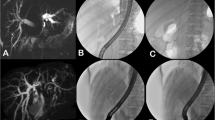Abstract
Background
Endoscopic biliary drainage is the palliative treatment of choice in patients with malignant hilar biliary obstruction. Contrast injection can lead to cholangitis, whereas air cholangiography may have a lesser incidence of cholangitis.
Objective
The objective of the present study is to prospectively compare the efficacy and safety of air vs. dye cholangiogram in malignant hilar biliary obstruction.
Methods
Patients with type II and III malignant hilar biliary stricture were included in a prospectively randomized manner at a tertiary care center. Unilateral self-expanding metal stent was placed in patients with a malignant hilar block using either air or dye as a contrast medium. Outcome measures were successful deployment, successful drainage, early complications, and procedure-related and 30-day mortality.
Results
Forty-nine patients were randomized to air cholangiogram (25 patients, group A) or dye cholangiogram (24 patients, group B). Most of the patients had type II stricture (19 in group A and 20 in group B). Successful stenting and drainage were achieved in 25 (100 %) and 24 (96 %) in group A and 23 (95.8 %) and 22 (91.6 %) (p = ns), respectively. Cholangitis developed in 1 (4 %) and 4 (16.6 %) in group A and B, respectively (p < 0.05). There was no procedure-related or 30-day mortality.
Conclusion
Use of air cholangiography was as safe and as effective as dye cholangiography in patients with malignant hilar biliary obstruction, and it decreased the risk of post-ERCP cholangitis.


Similar content being viewed by others
References
Bismuth H, Castaing D, Traynor O. Resection or palliation: priority of surgery in the treatment of hilar cancer. World J Surg. 1988;12:39–47.
Guthrie CM, Haddock G, De Beaux AC, Garden OJ, Carter DC. Changing trends in the management of extrahepatic cholangiocarcinoma. Br J Surg. 1993;80:1434–9.
Black K, Hanna SS, Langer B, Jirsh DW, Rider WD. Management of carcinoma of the extrahepatic bile duct. Can J Surg. 1978;21:542–5.
Stain SC, Baer HU, Dennison AR, Blumqart LH. Current management of hilar cholangiocarcinoma. Surg Gynecol Obstet. 1992;175:579–88.
Nakayama T, Ikeda A, Okuda K. Percutaneous transhepatic drainage of the biliary tract: technique and results in 104 cases. Gastroenterology. 1978;74:554–9.
Hatfield AR, Tobias R, Terblanche J. Preoperative external biliary drainage in obstructive jaundice. A prospective controlled clinical trial. Lancet. 1982;2:896–99.
Soehendra N, Reynders–Frederix V. Palliative bile duct drainage—a new endoscopic method of introducing a transpapillary drain. Endoscopy. 1980;12:8–11.
Tytgat GN, Bartelsman JF, Den Hartog Jager FC, Huibregtse K, Mathus-Vliegen EM. Upper intestinal and biliary tract endoprosthesis. Dig Dis Sci. 1986;31 Suppl 9:57S–76.
Lammer J, Neumayer K, Steiner H. Biliary endoprosthesis in tumors at the hepatic duct bifurcation. Eur J Radiol. 1986;6:275–9.
Deviere J, Baize M, de Toeuf J, Cremer M. Long-term follow-up of patients with hilar malignant stricture treated by endoscopic internal biliary drainage. Gastrointest Endosc. 1988;34:95–101.
Chang WH, Kortan P, Haber GB. Outcome in patients with bifurcation tumors who undergo unilateral versus bilateral hepatic drainage. Gastrointest Endosc. 1998;47:354–62.
Polydorou AA, Chisholm EM, Romanos AA, et al. A comparison of right versus left hepatic endoprosthesis insertion in malignant hilar biliary obstruction. Endoscopy. 1989;21:266–71.
De Palma GD, Galloro G, Siciliano S, Lovino P, Catanzano C. Unilateral versus bilateral endoscopic hepatic duct drainage in patients with malignant hilar biliary obstruction: results of a prospective randomized, and controlled study. Gastrointest Endosc. 2001;53:547–53.
Rerknimitr R, Kladcharoen N, Mahachai V, Kullavanijaya P. Result of endoscopic biliary drainage hilar cholangiocarcinoma. J Clin Gastroenterol. 2004;38:518–23.
Rerknimitr R, Attasaranya S, Kladchareon N, Mahachai V, Kullavanijaya P. Feasibility and complications of endoscopic biliary drainage in patients with malignant biliary obstruction at King Chulalongkorn Memorial Hospital. J Med Assoc Thail. 2002;85 Suppl 1:S48–53.
De Palma GD, Pezzullo A, Rega M, Persico M, Patrone F, Mastantuono L. Unilateral placement of metallic stents for malignant hilar obstruction: a prospective study. Gastrointest Endosc. 2003;58:50–3.
Sud R, Puri R, Hussain S, Kumar M, Thawrani A. Air cholangiogram: a new technique for biliary imaging during ERCP. Gastrointest Endosc. 2010;72:204–8.
Singh V, Singh G, Gupta V, Gupta R, Kapoor R. Contrast-free air cholangiography-assisted unilateral plastic stenting in malignant hilar biliary obstruction. Hepatobiliary Pancreatol Dis Int. 2010;9:88–92.
Pisello F, Geraci G, Modica G, Sciume C. Cholangitis prevention in endoscopic Klatskin tumor palliation: air cholangiography technique. Langenbecks Arch Surg. 2009;394:1109–14.
Bismuth H, Corlette MB. Intrahepatic cholangioenteric anastomosis in carcinoma of the hilus of the liver. Surg Gynecol Obstet. 1975;140:170–8.
Dowsett JF, Vaira D, Hatfield AR, et al. Endoscopy biliary therapy using the combined percutaneous and endoscopy technique. Gastroenterology. 1989;96:1180–6.
Ducreux M, Liguory C, Lefebvre JF, et al. Management of malignant hilar biliary obstruction by endoscopy results and prognostic factors. Dig Dis Sci. 1992;37:778–83.
Figueras J, Lladó-Garriga L, Lama C, et al. Resection as elective treatment of hilar cholangiocarcinoma (Klatskin tumor). Gastroenterol Hepatol. 1998;21:218–23.
Sung JY, Costerton JW, Shaffer EA. Defence system in the biliary tract against bacterial infection. Dig Dis Sci. 1992;37:689–96.
Peters RA, Williams SG, Lombard M, Karani J, Westaby D. The management of high grade hilar strictures by endoscopic insertion of self-expanding metal endoprostheses. Endoscopy. 1997;29:10–6.
Acknowledgments
None.
Conflict of interest
RS, RP, NSC, AM, and PKJ all declare that they have no conflict of interest.
Ethics statement
The authors declare that the study was performed in a manner to conform with the Helsinki Declaration of 1975, as revised in 2000 and 2008 concerning Human and Animal Rights, and the authors followed the policy concerning informed consent as shown on Springer.com.
Author information
Authors and Affiliations
Corresponding author
Rights and permissions
About this article
Cite this article
Sud, R., Puri, R., Choudhary, N.S. et al. Air cholangiogram is not inferior to dye cholangiogram for malignant hilar biliary obstruction: A randomized study of efficacy and safety. Indian J Gastroenterol 33, 537–542 (2014). https://doi.org/10.1007/s12664-014-0516-5
Received:
Accepted:
Published:
Issue Date:
DOI: https://doi.org/10.1007/s12664-014-0516-5




